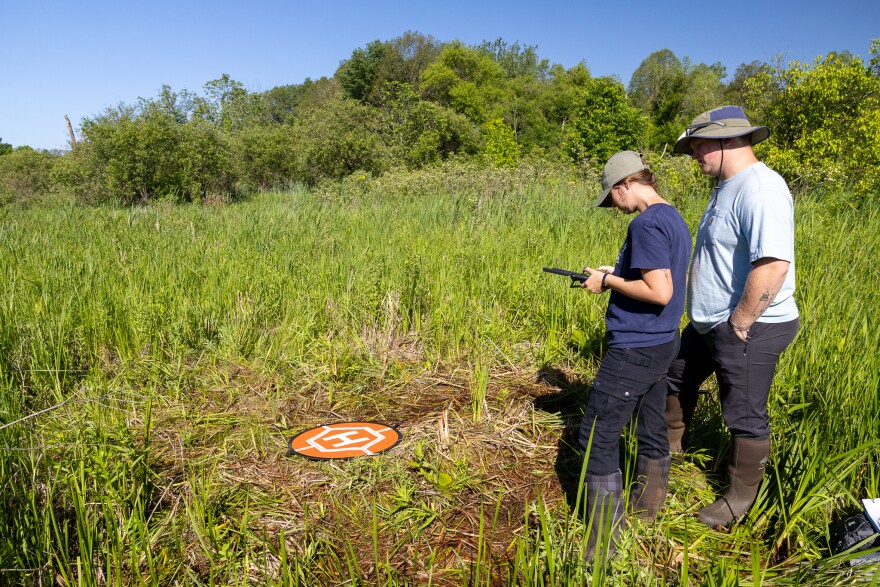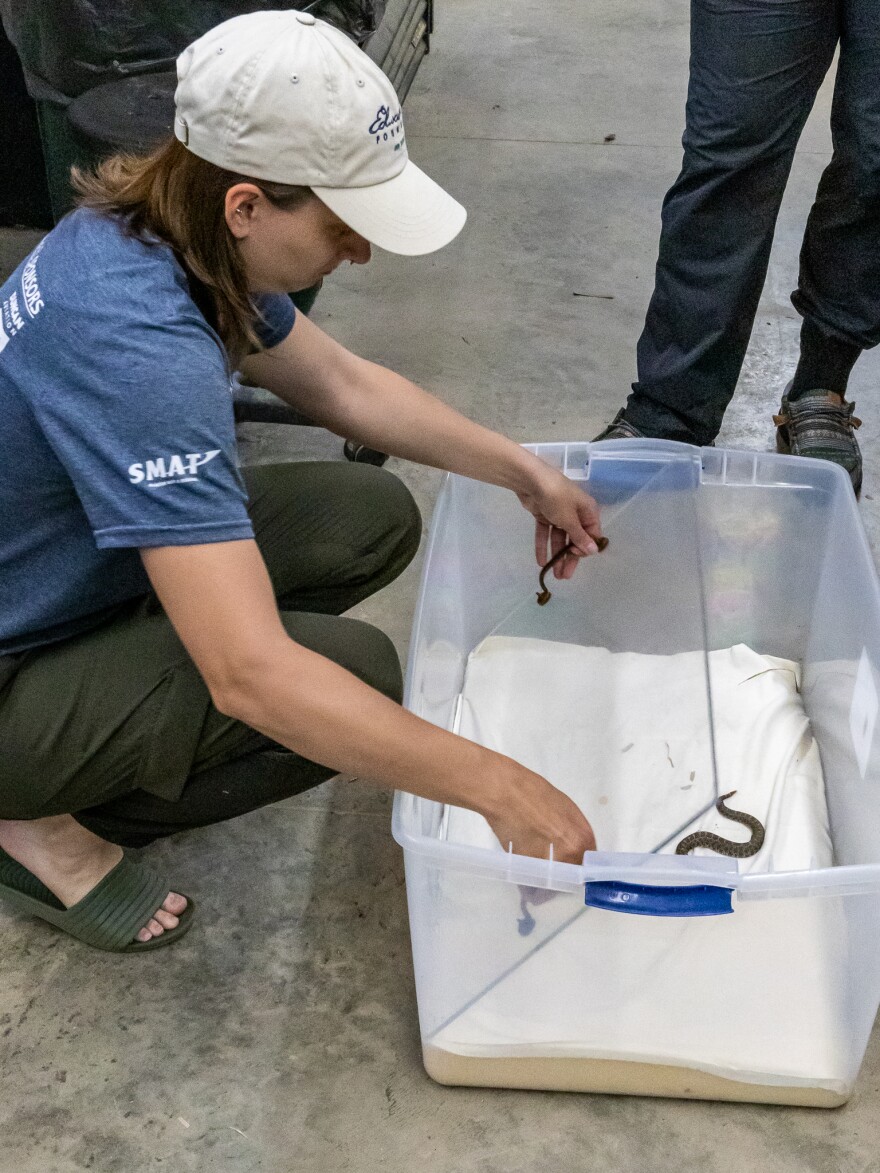Standing together at Pierce Cedar Creek Institute near Hastings, the two students stared intently at the screen, looking for the subtle signs of the small rattlesnake they were trying to find.
The eastern massasauga, Michigan’s only rattlesnake, typically hides in dense vegetation in wetlands and conservation biologists are concerned about trampling their sensitive wetland habitats to study them.
To avoid that issue, researchers are using drones equipped with heat-sensitive cameras to find them.
“What I’m looking for is anything that looks what we call ‘snakey,’” said Brody Glei, a student at Grand Valley State University, as he looks at the screen with the camera feed.
“Where it’s either kind of looking like an S-curve or if it’s in some weird shape that doesn’t really look like vegetation.”

Searching for rattlesnakes with drones
Those trying to study the rare and elusive eastern massasauga rattlesnake are hampered by the snake's secretive behavior.
Massasaugas hide so well that researchers often walk by just inches away without seeing them, Glei said.
The Grand Valley State University team is hoping using the drones will facilitate finding the snakes, but it is an untested method for snake surveys.
And it can be difficult identifying what the camera is seeing.
“It can be really tricky to pinpoint what is a snake or what is just a really hot piece of vegetation,” said Ava Whitlock, another student researcher on the project.

“When all that stuff heats up, it’s just difficult to pick out what exactly you’re looking at on the screen,” she said.
Whitlock and Glei took turns flying the drone and watching the screen for snakes. When they spot a potential candidate, the other goes to check on what the camera detected.
There were a few false alarms that day.
Whitlock saw a dark spot on the screen and zoomed the camera in to identify it. “Oh, it’s just another bird,” she said.
They were joined by another field crew who searched for snakes the old-fashioned way — walking through the area and searching the vegetation for massasaugas.
The two crews worked together, talking on radios and testing which method was more successful in finding the secretive snakes.

When the drone found a snake, Glei and Whitlock directed the ground crew to check if it was a massasauga.
But no luck.
“Fourth garter,” said Andrew Medley, one of the ground crew members, confirming the snake was another species.
While the more common garter was not the focus of this study, the students still record any snakes found.
When Marianna Vanderweide, a member of the research ground crew, discovered a massasauga in an area the drone had not flown over yet, Whitlock and Glei directed the drone to the area to check if the drone would have picked it out from the vegetation.
“Okay, I think we can see it,” Glei said. A few seconds later Whitlock confirmed the sighting. “Yeah, it’s right there,” she said.
The crew carefully caught the rattlesnake to bring it back to the lab for processing.

Handling the rattlesnakes safely
While eastern massasaugas are venomous, they are reluctant to bite people, Whitlock said.
“They’re timid,” she said. “Their first response is normally to just sit and hide and hope you don’t see them.”
Jennifer Moore, an associate professor at Grand Valley State University who studies the eastern massasauga, said there’s always the risk of snakebite and she trains the students to handle the snakes safely.
“We’ve developed a protocol over the years that really minimizes the risk to the snakes and to the handlers,” Moore said.
The protocol starts in the field.
The students carry buckets with pillowcases and when they find a massasauga, “one person is going to take their tongs and then grab the snake very carefully and just put them in the pillowcase in the bucket,” Whitlock said.
The snakes are carried back to the lab, where the students measure them, take a blood sample and mark the snakes with a tracking device.
“If we do recapture it, we can identify the snake and be like, okay, we found this snake this day, this site, this place,” Whitlock said.
The students put the snake in a container with a foam bottom. They then transferred it from the pillowcase to the container and pressed a plexiglass panel on it, pinning it into the foam.


After measuring its length under the panel, the team carefully maneuvered the snake head-first into a narrow plastic tube, keeping the venomous fangs at a safe distance to take the blood sample and install the tracking device.


The snake was also marked with a little nail polish on the rattles for easier identification in the field. Researchers planned to release the snake later that day back where it was found.

Eastern massasauga conservation
Using drones to supplement researchers’ visual surveys would not only free up staff time, Moore said, but would also reduce the effects of walking through their habitats.
"We don’t necessarily want to be trampling on that habitat as much as we are,” she said.
The massasaugas tend to occur in rare and sensitive wetlands called fens that also often harbor lots of rare and threatened species, she said, and using drones would also be less labor-intensive than the current method.
“Drones aren’t cheap, but neither is paying people to do visual surveys.” Moore said. “Over the long term it would be much cheaper and less impactful to the environment."
Researching the eastern massasauga helps to bring more understanding to their role in Michigan's ecosystem.
“If you like to have beautiful wetlands and all the ecosystem services that they provide for us, like water filtration and harboring biodiversity,” Moore said, “then you might want to give eastern massasaugas a pass and appreciate them for what they are.”

